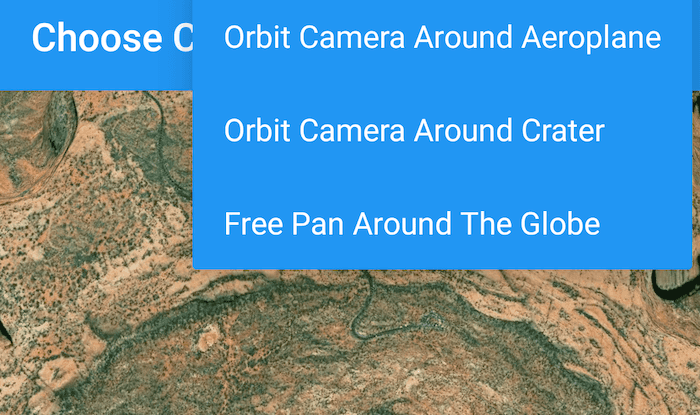Control the behavior of the camera in a scene.

Use case
The globe camera controller (the default camera controller in all new scenes) allows a user to explore the scene freely by zooming in/out and panning around the globe. The orbit camera controllers fix the camera to look at a target location or geoelement. A primary use case is for following moving objects like cars and planes.
How to use the sample
The application loads with the default globe camera controller. To rotate and fix the scene around the plane, exit globe mode by choosing the "Orbit camera around plane" option (i.e. camera will now be fixed to the plane). Choose the "Orbit camera around location" option to rotate and centre the scene around the location of the Upheaval Dome crater structure, or choose the "Free pan round the globe" option to return to default free navigation.
How it works
- Create an instance of a class extending
CameraController:GlobeCameraController,OrbitLocationCameraController,OrbitGeoElementCameraController. - Set the scene view's camera controller with
sceneView.cameraController = CameraController.
Relevant API
- ArcGISScene
- Camera
- GlobeCameraController
- OrbitGeoElementCameraController
- OrbitLocationCameraController
- SceneView
Tags
3D, camera, camera controller
Sample Code
/*
* Copyright 2019 Esri
*
* Licensed under the Apache License, Version 2.0 (the "License");
* you may not use this file except in compliance with the License.
* You may obtain a copy of the License at
*
* http://www.apache.org/licenses/LICENSE-2.0
*
* Unless required by applicable law or agreed to in writing, software
* distributed under the License is distributed on an "AS IS" BASIS,
* WITHOUT WARRANTIES OR CONDITIONS OF ANY KIND, either express or implied.
* See the License for the specific language governing permissions and
* limitations under the License.
*/
package com.esri.arcgisruntime.sample.choosecameracontroller
import android.os.Bundle
import android.util.Log
import android.view.Menu
import android.view.MenuItem
import android.widget.Toast
import androidx.appcompat.app.AppCompatActivity
import androidx.core.content.ContextCompat
import com.esri.arcgisruntime.ArcGISRuntimeEnvironment
import com.esri.arcgisruntime.geometry.Point
import com.esri.arcgisruntime.geometry.SpatialReferences
import com.esri.arcgisruntime.mapping.*
import com.esri.arcgisruntime.mapping.view.Camera
import com.esri.arcgisruntime.mapping.view.GlobeCameraController
import com.esri.arcgisruntime.mapping.view.Graphic
import com.esri.arcgisruntime.mapping.view.GraphicsOverlay
import com.esri.arcgisruntime.mapping.view.LayerSceneProperties
import com.esri.arcgisruntime.mapping.view.OrbitGeoElementCameraController
import com.esri.arcgisruntime.mapping.view.OrbitLocationCameraController
import com.esri.arcgisruntime.mapping.view.SceneView
import com.esri.arcgisruntime.sample.choosecameracontroller.databinding.ActivityMainBinding
import com.esri.arcgisruntime.symbology.ModelSceneSymbol
import java.io.BufferedInputStream
import java.io.BufferedOutputStream
import java.io.File
import java.io.FileOutputStream
class MainActivity : AppCompatActivity() {
private val activityMainBinding by lazy {
ActivityMainBinding.inflate(layoutInflater)
}
private val sceneView: SceneView by lazy {
activityMainBinding.sceneView
}
private val toolbar: androidx.appcompat.widget.Toolbar by lazy {
activityMainBinding.toolbar
}
private lateinit var sceneOverlay: GraphicsOverlay
private lateinit var plane3d: Graphic
private lateinit var orbitLocationCameraController: OrbitLocationCameraController
private lateinit var orbitPlaneCameraController: OrbitGeoElementCameraController
override fun onCreate(savedInstanceState: Bundle?) {
super.onCreate(savedInstanceState)
setContentView(activityMainBinding.root)
// authentication with an API key or named user is required to access basemaps and other
// location services
ArcGISRuntimeEnvironment.setApiKey(BuildConfig.API_KEY)
// load plane model and texture from assets into cache directory
copyFilesFromAssetsToCache(resources.getStringArray(R.array.required_files_array))
// setup Toolbar
setSupportActionBar(toolbar)
toolbar.overflowIcon = ContextCompat.getDrawable(this, R.drawable.ic_photo_camera)
// create a scene and add it to the scene view
sceneView.scene = ArcGISScene(BasemapStyle.ARCGIS_IMAGERY)
// add base surface for elevation data
with(Surface()) {
this.elevationSources.add(
ArcGISTiledElevationSource(
getString(R.string.world_elevation_service_url)
)
)
sceneView.scene.baseSurface = this
}
// create a graphics overlay for the scene
sceneOverlay = GraphicsOverlay()
sceneOverlay.sceneProperties.surfacePlacement =
LayerSceneProperties.SurfacePlacement.ABSOLUTE
sceneView.graphicsOverlays.add(sceneOverlay)
// create a camera and set it as the viewpoint for when the scene loads
val camera = Camera(38.459291, -109.937576, 5500.0, 150.0, 20.0, 0.0)
sceneView.setViewpointCamera(camera)
// instantiate a new camera controller which orbits a target location
with(Point(-109.929589, 38.437304, 1700.0, SpatialReferences.getWgs84())) {
orbitLocationCameraController = OrbitLocationCameraController(this, 5000.0).apply {
this.cameraPitchOffset = 3.0
this.cameraHeadingOffset = 150.0
}
}
loadModel().addDoneLoadingListener {
// instantiate a new camera controller which orbits the plane at a set distance
orbitPlaneCameraController = OrbitGeoElementCameraController(plane3d, 100.0).apply {
this.cameraPitchOffset = 30.0
this.cameraHeadingOffset = 150.0
}
}
}
override fun onCreateOptionsMenu(menu: Menu): Boolean {
menuInflater.inflate(R.menu.camera_controller_menu, menu)
return super.onCreateOptionsMenu(menu)
}
override fun onOptionsItemSelected(item: MenuItem): Boolean {
sceneView.cameraController = when (item.itemId) {
R.id.action_camera_controller_plane -> orbitPlaneCameraController
R.id.action_camera_controller_crater -> orbitLocationCameraController
R.id.action_camera_controller_globe -> GlobeCameraController()
else -> return super.onOptionsItemSelected(item)
}
return true
}
/**
* Load the plane model from the cache, use to construct a Model Scene Symbol and add it to the scene's graphic overlay.
*/
private fun loadModel(): ModelSceneSymbol {
// create a graphic with a ModelSceneSymbol of a plane to add to the scene
val pathToModel =
cacheDir.toString() + File.separator + getString(R.string.file_bristol_model)
val plane3DSymbol = ModelSceneSymbol(pathToModel, 1.0)
plane3DSymbol.heading = 45.0
plane3d =
Graphic(
Point(-109.937516, 38.456714, 5000.0, SpatialReferences.getWgs84()),
plane3DSymbol
)
sceneOverlay.graphics.add(plane3d)
return plane3DSymbol
}
/**
* Copy the given file from the app's assets folder to the app's cache directory.
*
* @param files as String
*/
private fun copyFilesFromAssetsToCache(files: Array<String>) {
applicationContext.assets?.let { assetManager ->
files.forEach { filename ->
with(File(cacheDir.toString() + File.separator + filename)) {
if (!this.exists()) {
try {
val bis = BufferedInputStream(assetManager.open(filename))
val bos = BufferedOutputStream(
FileOutputStream(cacheDir.toString() + File.separator + filename)
)
val buffer = ByteArray(bis.available())
var read = bis.read(buffer)
while (read != -1) {
bos.write(buffer, 0, read)
read = bis.read(buffer)
}
bos.close()
bis.close()
Log.i(logTag, "$filename copied to cache.")
} catch (e: Exception) {
logToUser(
getString(
R.string.error_writing_to_cache,
filename,
e.message
)
)
}
} else {
Log.i(logTag, "$files already in cache.")
}
}
}
}
}
override fun onResume() {
super.onResume()
sceneView.resume()
}
override fun onPause() {
sceneView.pause()
super.onPause()
}
override fun onDestroy() {
sceneView.dispose()
super.onDestroy()
}
/**
* AppCompatActivityExtensions
*/
private val AppCompatActivity.logTag: String get() = this::class.java.simpleName
private fun AppCompatActivity.logToUser(message: String) {
Toast.makeText(this, message, Toast.LENGTH_LONG).show()
Log.d(logTag, message)
}
}